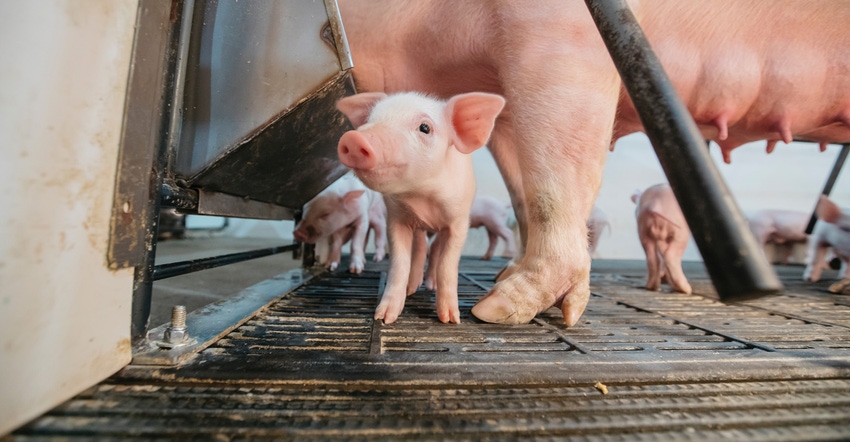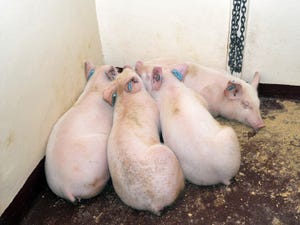Answers 'beyond the bottle'
Illinois veterinarian test-drives whole-herd approach.

John Waddell will admit there are very few cases where a vaccine is a stand-alone answer to a swine disease challenge.
"Seldom does the answer to disease challenges come all alone in the bottle," says the senior professional services veterinarian with Boehringer Ingelheim.
"We know the vaccines are effective, because proven efficacy is required before a license is issued. However, there are many other factors 'beyond the bottle' of vaccine that determine if those vaccines will meet expectations when administered to pigs. It's a matter of giving a vaccine every chance of being effective when there's a lot of other factors involved with control of diseases.
"This is especially true on the more complex diseases such as PRRS, influenza, mycoplasma and salmonella — to name a few — which we have found require a 'whole-herd approach,' since the various phases of production are linked via an 'infection chain' from gilts to sows to piglets to market animals."
Minimizing transmission and optimizing immunity are the key components behind Boehringer Ingelheim's whole-herd approach, a control plan aimed at eliminating endemic (continuous circulation in a population) diseases from swine herds.
Using a WHA from farrowing to market has been a vital part of controlling diseases such as porcine reproductive and respiratory syndrome, mycoplasma and salmonella, and is especially important when dealing with influenza A in sow herds.
"Each phase of production is important, but the risk of transmission varies by pathogen and disease," says Waddell.
"We have learned a great deal from decades of dealing with PRRS virus, but there are differences with IAV-S [influenza A virus in swine], since — unlike PRRS — pigs are born free of influenza and then become infected from either older pigs in the farrowing house, their dams, or laterally from other sources of the virus, such as farm personnel or recently introduced replacements."

Stopping the cycle
Tired of just accepting the status quo each flu season for a breed-to-wean herd he works with, Clayton Johnson, a veterinarian with Carthage Veterinary Service, decided to test out the WHA strategy last winter. The closed-herd farm made all its own replacements and never had any new animals coming on-site, and it had strong biosecurity protocols in place and great isolation. The downside with that type of system, Johnson says, is dealing with endemic diseases such as IAV-S that are introduced as the farm is stocked, or thereafter.
"Any pathogen that's not currently in a farm has the potential to become endemic if introduced, unless you find a way to break the cycle," Johnson says. "Generally, to break that cycle of endemic infection, you are likely to have to stop keeping your own replacement animals, creating a partial depopulation to let the virus burn out by not ever allowing nonimmune weaned pigs to perpetuate pathogen replication. Breaking the endemic circulation of disease by herd closure or partial depopulation has been the historic dogma that exists among swine veterinarians."
With PRRS or mycoplasma, Johnson says production systems may go to those extremes despite the high cost in terms of the overall impact on production. When it comes to influenza, producers and veterinarians have traditionally taken the approach "just live with it," rather than incur the hit to productivity of creating a hole in the inventory of breeding females.
When Johnson first learned of the WHA strategy, he admits he was skeptical; but then he realized if he was going to implement such a protocol, he had the perfect herd in which to try it.
"We liked the idea of an approach to see if we could get the virus to 'burn out,' rather than moving animals off-site and potentially creating a hole in production," Johnson says. "It offered a chance to create a population of animals that were so well immunized that there was no place for the virus to hide. This WHA combined creating piglets with robust immunity with tools to minimize their exposure to the field virus."

Maximizing immunity
To begin, Johnson worked with the Boehringer Ingelheim technical team to design the vaccination program for the herd, focusing on maximizing immunity of the suckling piglets. Knowing every farm offers unique situations and circumstances, the influenza vaccination protocol was designed after taking into account the various constraints of the farm, its current status, and timing and age of flu exposure and infection onset.
"In this particular situation, to optimize the timing of vaccination as best we could, we decided to process the pigs at 7 days of age for the duration of the intense vaccination phase of the project," Johnson says. "We intentionally delayed processing a couple of days from when the farm traditionally processed to allow customization of the timing of the live attenuated influenza vaccine, while minimizing disruption of the farm's routine workflow. This phase of the protocol lasted eight weeks."
At the onset of the intensive immunization phase of the program, all animals in the on-site gilt development unit received a dose of LAIV to create uniform and strong IAV-S immunity, and aid in minimizing transmission within and beyond that phase of production.
Healthy habits
"In addition to customizing the influenza vaccination protocols to maximize immunity, Boehringer Ingelheim recognizes the importance of implementing essential management and biosecurity practices designed to reduce transmission of pathogens within and across populations of pigs," Waddell says. "Each of these practices are important by themselves, but when combined, make up good production practices that should become 'healthy habits' on most farms wanting long term solutions, especially for IAV-S control."
Waddell says that besides optimizing the immunization protocol, it is equally important to consider critical items such as limiting movement of young pigs; group-to-group hygiene; attention to caregiver movements, intentionally moving from younger to older piglets in the lactation phase; all-in and all-out movements between rooms or barns; paying attention to the health status of herd additions; how new arrivals (replacements) are managed if housed on-site; and, with IAV-S specifically, implementing a sick-worker plan.
One of the non-negotiables for Johnson's WHA project was management of the GDU. The gilt developer has 12 individual wean-to-finish rooms that each hold about two-and-a-half weeks' worth of gilts. Each room of the GDU houses internal replacement gilts within 17 days of age.
"Within about a 17-day period, there literally could be 12 or 13 days where we are introducing new weaned replacement gilts to the population of a single room in the GDU, and that challenges disease elimination efforts," Johnson says.
To work around that, during portions of the WHA project, the farm implemented a Danish entry system between the rooms in the GDU, with dedicated coveralls and boots for employees who went into the different age groups of gilts. The Danish entry practice, as well as strictly enforcing an all-in, all-out approach, was also used in the holding rooms, an area for recently weaned piglets being staged for shipping twice per week.
"That was a bit of a challenge for this farm, as it has a customer for its gilts, and outside sales and a different customer for the barrows; so, when the truck shows up to pick up weaned pigs, you are either loading gilts or barrows, while the alternate gender of weaned pigs is asked to stay in the holding room until the next truck shows up," Johnson says. "That was a little bit of a logistical challenge to pull off, but we felt it was an essential step in the success of the whole-herd approach."
Improving group-to-group hygiene and incorporating all-in, all-out practices are just two of the healthy habits Boehringer Ingelheim recommends when implementing a WHA.
"With influenza, we urge producers to limit movements of young pigs within the farrowing house by being mindful of, and limiting, cross-fostering, especially during critical phases of the project," Waddell says. "Limit suckling pig movements between litters as much as possible. Practicing group-to-group hygiene and altering worker movement patterns within the farrowing and lactation sections are essential for success with reducing and eliminating transmission of IAV-S."
Another important factor, according to Waddell, is identifying new influenza breaks in incoming gilts.
"While the Carthage farm was not introducing externally sourced replacements in this case, properly managing new arrivals by quarantining or limiting movement is another important healthy habit to minimize transmission within the infection chain," Waddell says.

Preliminary results are promising
Thus far in the WHA program, Johnson says the site has accomplished several of the milestones it had hoped to, specifically not having a polymerase chain reaction-positive test, either in the holding rooms or GDU, for the past two months.
"We've seen clinical signs completely go away in all ages of pigs," Johnson says. "We don't have any sort of coughing in late lactation, and when you wean the pigs and get them out in the hallway, they don't cough. When we put them in the holding room, they still don't cough. That's pretty unique from a herd that had been endemic with influenza. Our external customers have been extremely happy with the lack of influenza clinical signs since implementation of the WHA program. Similar to what we're seeing, they aren't dealing with the clinical signs of influenza that plague so many piglets during the early postweaning stages."
The continuous flow in the GDU proved more difficult than farrowing, as the farm staff saw positive PCR testing on younger gilts early in the project, but ongoing weekly testing has now yielded months of negative results from the GDU.
In addition to neonatal vaccination, the site is also continuing LAIV vaccination of the internal replacement gilts at weaning. The farm staff will continue routine IAV-S diagnostic monitoring in its high-risk areas, as well as ongoing monitoring of clinical signs.
Overall improvements in the health and performance of the pigs produced from the farm have been remarkable, and Johnson is hopeful the site will make it through flu season this winter with no new breaks. "With the excellent biosecurity we have, we've been fortunate to only see one influenza infection in the last three years," Johnson says. "I think the farm will eventually see a new influenza infection, but I see no reason we can't have several years of influenza-negative pigs between outbreaks."
In terms of next steps, Johnson says he already has his eyes on three other farms where he'd like to implement a WHA, all of which have a similar setup with internal replacement gilts and endemic influenza.
Johnson says he hopes the industry will continue to be more creative in its approach to using LAIV vaccination for influenza A virus in swine. He gives the example of the modified-live vaccine for PRRS, where producers and veterinarians continue to discover and implement new twists to solve old problems.
"If at first you don't succeed, try, try again," Johnson says. "Be creative. Think through the situations where there are specific applications for vaccines; and low-risk approaches, which can have high-impact results when they are successful."
Waddell echoes Johnson's sentiment, and says knowing when and where to implement disease management strategies is critical. "As our industry continues to consolidate and become larger and more specialized, it's more important than ever that we utilize every tool in our toolbox."
"Strategies like the whole-herd approach, combined with tools we already use in commercial herds for flu elimination, give us a lot of hope for the future," Johnson says. "We can now say with confidence as, we have with PRRS and PED [porcine epidemic diarrhea], 'We're not going to live with endemic influenza.' Even if there are no clinical signs in the sow farm, we don't want the endemic infection — because there is a cost to somebody in the supply chain."
About the Author(s)
You May Also Like





